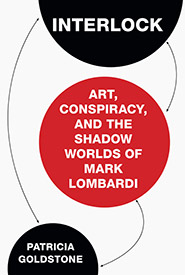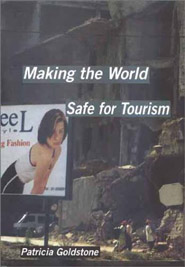Patricia Goldstone
author, playwright, journalist
Patricia Goldstone
author, playwright, journalist
Interlock
 Without exception all those who “knew” Mark Lombardi say they never knew him well – certainly not well enough to know what he was really after in stringing together a stunning continual visual record of the cozy relations between intelligence agencies and organized crime in funding half a century’s worth of black operations and illicit wars. INTERLOCK unpicks that mystery with the tools of biography rather than art criticism to come up with some highly unexpected and fascinating answers.
Without exception all those who “knew” Mark Lombardi say they never knew him well – certainly not well enough to know what he was really after in stringing together a stunning continual visual record of the cozy relations between intelligence agencies and organized crime in funding half a century’s worth of black operations and illicit wars. INTERLOCK unpicks that mystery with the tools of biography rather than art criticism to come up with some highly unexpected and fascinating answers.
A working-class outsider who busted his way into the privileged art world, Lombardi used Conceptualism’s emphasis on ideas over aesthetics and execution to hide his own early lack of drawing and painterly technique, but also as a great actor might use a series of masks to hide his true intention. Marcel Duchamp, the father of Dada who used ordinary objects such as the famous urinal to create heavily ironic anti-art works based in anti-bourgeois, anti-war politics, was the artist he admired most.
Shrewdly manipulating the pretensions of art-speak, Lombardi created his art from quite another form of ordinary object – an arcane litigation tool known as an interlock search, a prosaic accounting device which art specialists, understandably, failed to recognize but which is immediately familiar to attorneys who often refer to it as a “flow of funds” chart. Art historians and critics also failed to realize that his drawings, at least initially, were executed under the patronage of a powerful politician who used his interlocks to investigate her opposition behind the scenes.
Popular among trust-busting attorneys in the 1970s – the last time busting monopolies was itself popular – an interlock search is a form of flow-chart cross-referencing the boards of companies suspected to have overly cozy links. The artist, at first struggling to find his own, unique voice, expanded the definition of “corporation” to encompass the shadowy entities between offshore banking and global money-laundering. The interlocks between the oil cartel and the seven biggest American banks in the 1980s were his favorite area of research.
 The one thing Lombardi clearly did want, from a very early age, was fame. His mature work, in over 25 monumental drawings executed between 1994 and March 2000, reveal sensationally how “hot” money derived from criminal activities has inextricably bonded to more legitimate funds chasing high returns on investment in the unregulated or “shadow” reaches of the world economy, where loopholes in foreign exchange restrictions have been freely exploited by the Mafia and various intelligence agencies since the end of World War Two, and where capital flow, now infused with petrodollars and exponentially enhanced by derivatives, has swelled to volumes that can either rescue struggling treasuries or swamp financial markets with floods of fugitive liquidity. In one of his essential series, “The Pope and His Bankers,” Lombardi traced how the Mafia patented the use of modern derivatives as money-laundering instruments. I explain in INTERLOCK how he linked his drawings together to suggest the building, over time, of a single network which like a predatory organism has consumed the ecology that nourished it.
The one thing Lombardi clearly did want, from a very early age, was fame. His mature work, in over 25 monumental drawings executed between 1994 and March 2000, reveal sensationally how “hot” money derived from criminal activities has inextricably bonded to more legitimate funds chasing high returns on investment in the unregulated or “shadow” reaches of the world economy, where loopholes in foreign exchange restrictions have been freely exploited by the Mafia and various intelligence agencies since the end of World War Two, and where capital flow, now infused with petrodollars and exponentially enhanced by derivatives, has swelled to volumes that can either rescue struggling treasuries or swamp financial markets with floods of fugitive liquidity. In one of his essential series, “The Pope and His Bankers,” Lombardi traced how the Mafia patented the use of modern derivatives as money-laundering instruments. I explain in INTERLOCK how he linked his drawings together to suggest the building, over time, of a single network which like a predatory organism has consumed the ecology that nourished it.
His relentless pursuit led him deep into the tangled relationships between banking, intelligence and crime. This was his shot at the fame he craved, and he took it. Just as success seemed assured, he was discovered hanged in his studio. INTERLOCK examines the gaps in the investigation that ruled his case a suicide.
Cocky, funny, and mischievous, Lombardi would be the first to appreciate the joke that, in his next incarnation the three-letter agencies of the United States he made a career of studying would be tasked with studying him. In the immediate aftermath of 9/11, the CIA, the FBI, the NSA, the DoD (Department of Defense) and the ONR (Office of Naval Research) were obliged to take crash courses in social-network analysis in order to figure out linkages between terrorist groups. The “rhizomatic” drawings of Mark Lombardi were a prime focus of their attention.
Lombardi Drawings of Graphs – Journal of Graph Algorithms and Applications
Mark Lombardi’s Narrative Structures and Other Mappings of Power Relations
Mark Lombardi by Devon Golden, Bomb Magazine
A rhizome is a subterranean plant system. It is also a highly influential concept developed by French philosophers Gilles Deleuze and Félix Guattari, an “image of thought” in theory and research that resists conventional, treelike up-and down organizational structure that charts causality along chronological lines between an origin and a conclusion. A rhizomatic thought structure presents history and culture as a wide array of attractions and influences with no specific genesis, for a “rhizome has no beginning or end; it is always in the middle, between things, interbeing, intermezzo,” a concept which applies particularly to the “everything is connected”-ness of information science. Deleuze and Guattari’s post-modern theories are in fact linked by scholars to the design of hypertext and indeed to the deep structure of the Internet itself.
www.lombardinetworks.net/networks/services
Lombardi’s peculiar genius as an abstract artist was to incorporate these far-ranging philosophical elements into his work, and to integrate them with the prosaic accounting principle of the interlock. Consciously or unconsciously he answered one of the greatest challenges of the most advanced artificial intelligence simply by using the fundamentally human thought process of trying to draw the story out of the mass of data he had collected.
Today, 15 years after his death, the artist’s work has spun off a data-visualization industry that encompasses not only the national security complex but IBM, MIT, the PayPal Mafia of Silicon Valley and an ONR-funded computer program named, in his honor, the Lombardi Spirograph — an amazing achievement for an artist who publicly declared he had little use for the Internet. Says Roger Hurwitz, a research scientist who works with Tim Berners-Lee at MIT’s Computer Science and Artificial Intelligence Laboratory “Everyone who does social network analysis has looked at him.”
Over the years since Lombardi’s death, data visualization and/or pattern recognition have become the hot new frontiers of the artificial intelligence business. Ironically, the NSA is particularly challenged by the volume of the personal information it has collected by invading millions of private lives. Its attempts at graph analysis have tended towards what some computer scientists call “spaghetti”, i.e., the links conveying information are so dense that they run into each other and become unreadable. To computer scientists, the curved edges Lombardi painstakingly drew from node to node as a human means of narrative are a radical innovation in information analysis. Hurwitz says, “It’s really kind of amazing because it’s not figurative art but… it represents the social network in links that are nonetheless real — some social or economic exchange.”
Lombardi in fact sketched a well-known problem in the discipline of economics, where little or no consensus exists on how to measure the size of what is commonly known as the “shadow” or “underground” economy. In the second half of INTERLOCK I discuss in detail how his “one continual drawing in my head” visualizes the pooling of various clandestine funds into an exponentially expanding pot of black money that, because it remained secret for “reasons of national security,” remained out of the reach of any regulation – the definition of a shadow banking system. Lombardi’s famous BCCI series shows this malignant growth metastasized worldwide when covert funding was driven underground by the Congressional investigations of the 1970s and created the first subprime crises. Three weeks before his death, he completed a final version showing the entrance of the Russian mafiyeh, replete with oil, aluminum, and other plundered riches of the former Soviet Union, into the US banking system.
The ballooning distortions Lombardi drew suggest the impact of floods of hot money on the global economy. In a June 2008 speech, US Treasury Secretary Timothy Geithner placed significant blame for the freezing of credit markets on a run on the entities in the shadow banking system by their counterparties – who remained, literally, in the shadows. In the second half of INTERLOCK, I explain how the interlocks in Mark Lombardi’s drawings can be used to trace the financial scandals of the present day.
What do we know about non-bank interconnectedness? – Bank Underground
Appearances
Patricia Goldstone is probably the only woman writing on art to be interviewed by a podcast for Special Ops veterans broadcast to military bases all over the United States. She has made over 40 media appearances in connection with the publication of Interlock, including The Big Picture with Thom Hartmann, Forward Thinking/XM, The Jefferson Exchange on Jefferson Public Radio; Cool Science KCPW, Joe Donohue’s Roundtable on WAMC, The Jordan Rich Show WBZ, The Jim Engster Show, Morning Edition WOJB with Eric Schubring, Morning Edition KVON and Sofrep Radio. Her book tour included City Lights in collaboration with the San Francisco Art Institute, the Stella Adler Academy & Theatre, Book Soup, Vroman’s, and Book Court, with more engagements to come. Coverage of INTERLOCK has appeared in Newsweek, ArtNet, The Daily Beast, Bookslut and The San Francisco Review of Books, among others. In connection with her other books, Goldstone has also given a keynote address at Harvard University (“Tourisms,” Harvard School of Design), and spoken on C-Span for The Los Angeles Times Festival of Books. Patricia Goldstone can be reached via this website’s Contact feature for future speaking engagements.
©2023 Patricia Goldstone ~ Designed by Mesa Multimedia





